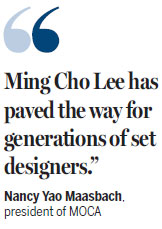
|
Ming Cho Lee (front) browses the exhibition of his work at the Museum of Chinese in America (MOCA) in New York with Herb Tam (right), MOCA's curator and director of exhibitions, on April 28. Niu Yue / For China Daily |
Ming Cho Lee said that as a Chinese American, his Chinese-ness has been rooted in his blood since birth.
Stage Design by Ming Cho Lee, a retrospective exhibition of celebrated and influential set designer Ming Cho Lee, is on view at the Museum of Chinese in America (MOCA) in New York through Sept 11.
As a recipient of the National Medal of Arts in 2002 and a Tony Award for Lifetime Achievement in 2013, Lee is one of the most acclaimed living set designers in the world.
With more than 40 original maquettes on view for the first time in New York since the 1990s, the exhibition explores the evolution of his work in theater, opera and dance from his groundbreaking abstract sets of the 1960s and 1970s, to his more recent hard-edge treatments.

The show was developed by Lee himself with his wife Betsy Lee and the New York Public Library for the Performing Arts in 1995 and has since traveled overseas, appearing in Shanghai, Taiwan and other venues.
"Ming Cho Lee has paved the way for generations of set designers and MOCA is honored to bring this retrospective to New York City - the center of the global theater community," said MOCA President Nancy Yao Maasbach.
Maasbach said the exhibition presents an unmatched body of work, in line with MOCA's tradition of highlighting cultural pioneers.
"His work draws upon two cultures, his childhood in China and his subsequent immersion in American art," critic Mel Gussow wrote in the April 1995 issue of American Theatre magazine.
Lee was born in Shanghai in the 1930s. His mother, Tang Ing, was a famous beauty and accomplished actress. His father, Lee Teu Fa, was a Yale-educated businessman. With his mother's encouragement, Lee studied landscape painting with a master Chinese landscape painter before coming to the United States. It is commonly understood that the skills and techniques he gained as an apprentice in China served as the basis for his iconic approach to the US stage.
Attending Occidental College in Los Angeles at the age of 19, Lee majored in speech and acted in student plays.
Lee recalled he was one of only three Chinese students on campus. Despite his atypical background during the period of exclusion in America, Lee never felt racism.
In his junior year, Lee turned to studying design and continued that interest at UCLA, where he complemented his traditional Chinese craft with studies of American art.
In the 1950s, with the encouragement of lighting expert Edward Kook, Lee moved to New York, where he apprenticed with Jo Mielziner, the dean of set design at the time. During this time, "Lee developed his own more sculptural style and found self-definition in the clean bold lines of his stage work," Gussow wrote.
Lee has been a freelance designer throughout his career. His most steady employment was as principal designer for the New York Shakespeare Festival for 11 years. During that stint, he did 22 stage designs for Shakespearean plays as well as contemporary works.
Lee has designed sets for the Metropolitan Opera, New York City Opera, Covent Garden in London and many other major opera houses around the world.
For more than 65 years, Lee has served on the faculty at the Yale School of Drama, including as the co-chair of the design department. Even though he is no longer doing design work, he still teaches twice a week in New Haven.
For Lee, design is a process of distillation and the most common thing he says to his students is: "You don't need it."
"In his designing, Lee is the enemy of decoration, of effects, of anything that detracts or distracts from the drama," Gussow wrote in the article.
Lee confessed that he can't speak putonghua (Mandarin) and remembers only Shanghainese dialect, but "nobody understood what I was talking about in Shanghai, because everybody speaks 'putonghua'," he said with a laugh.
"You cannot escape from who you are," he said. "And there are a lot of things that, even though you are not aware of it, it turned out there was a Chinese-ness sneaking in."